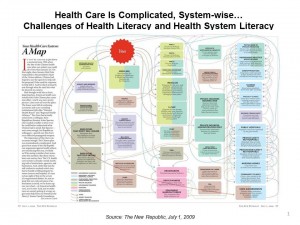 “Older patients, caregivers, and family members face growing challenges in understanding and navigating the nation’s increasingly complex healthcare system,” begins a well-articulated column called Why Consumers Struggle to Understand Health Care, in U.S. News & World Report dated January 27, 2012.
“Older patients, caregivers, and family members face growing challenges in understanding and navigating the nation’s increasingly complex healthcare system,” begins a well-articulated column called Why Consumers Struggle to Understand Health Care, in U.S. News & World Report dated January 27, 2012.
Health literacy isn’t just about understanding clinical directions for self-care, such as how to take medications prescribed by a doctor, or how to change a bandage and clean an infected area. Health literacy is also about how to effectively navigate one’s health system. The first graphic is a schematic published in the New Republic in 2009 which illustrates the arcane Trip-Tik that is the U.S. health system. I often use this drawing in presentations when I’m addressing the topic of health literacy in America.
And that skill is in short-supply in the U.S., U.S. News reports. Donald Berwick, recent head of the Centers for Medicare and Medicaid Services, wrote with colleagues in Health Affairs that, “Despite its importance, health literacy has until recently been relegated to the sidelines of healthcare improvement efforts.”
Lack of health literacy results in medical errors, patients presenting themselves to emergency rooms due to prescription drug dosing errors, asthmatic children through the ER revolving door when not regularly inhaling their medications, and overall sub-optimal health outcomes.
Health Populi’s Hot Points: One of my dearest friends is bravely battling multiple myeloma and, so far, so good. His clinical journey with the labyrinthine health system began in early December 2011 — about seven weeks ago.
He is on 23 medications now, administered at home. He was discharged from his inpatient stay without a system to help manage those meds at home. Home care workers get easily confused between names on bottles, some of which are called by their generic names, and some by their esoteric brands. He’s just completed many rounds of radiation, rang the bell in the facility to mark the end of that phase, and will continue a long phase of chemotherapy to be followed by stem cell transplant in a few months.
I spent an hour yesterday, January 29, 2012, at his home, helping his wife (another best friend) reconcile a four-inch-thick pile of paper explanations of benefit forms (EOBs) and bills from various health providers: two hospitals, two imaging centers, two clinical laboratory companies, an orthopedic surgeon, a nephrologist, and other providers whose specialties are hazy to me 24 hours later.
 Ironically, the front of each of the few dozen envelopes from the health plan containing the EOBs included the pre-printed phrase, “Be green with Blue,” shown in the graphic. Even if the EOBs came through email, that wouldn’t solve the very un-green challenge of health literacy, and lack of health data integration where all of this should be populating a digital worksheet to help consumers and caregivers manage the countless transactions that get billed in the U.S. health system.
Ironically, the front of each of the few dozen envelopes from the health plan containing the EOBs included the pre-printed phrase, “Be green with Blue,” shown in the graphic. Even if the EOBs came through email, that wouldn’t solve the very un-green challenge of health literacy, and lack of health data integration where all of this should be populating a digital worksheet to help consumers and caregivers manage the countless transactions that get billed in the U.S. health system.
My friend is a hospital administrator with a clinical undergraduate degree and an MBA in health administration. I am a health economist who has consulted with hospitals, physicians, and every kind of stakeholder organization in the health industry for over 20 years. Together, we have at least 50 years of health care system experience.
We morphed the four-inch-pile of bills and EOBs into six bulldog-clipped folders of health financial categories and questions:
- EOBs correctly reconciled to patient bills from health providers
- EOBs without provider bills
- Provider bills without EOBs
- EOBs with denials from the health plan
- A survey form from a third party administrator for the health plan asking to clarify the context of an inpatient procedure that may or may not be denied
- A sixth category of “need more information.”
I won’t even go into the “patient’s responsibility” financial bottom-line (thus far – it’s only 7 weeks into what will be many months of health services from dozens of billing providers).
We are all health illiterates, my girlfriend and I remarked to each other over tea, exhaling over our six piles of prideful organizing. This is just the beginning. Now, to get the data into a Quicken Health spreadsheet…




 Thanks to Feedspot for naming this blog, Health Populi, as a
Thanks to Feedspot for naming this blog, Health Populi, as a